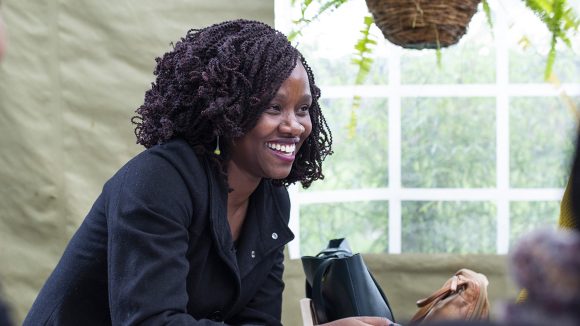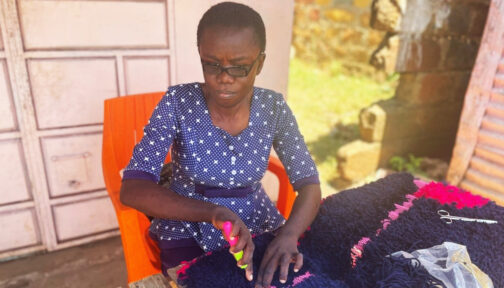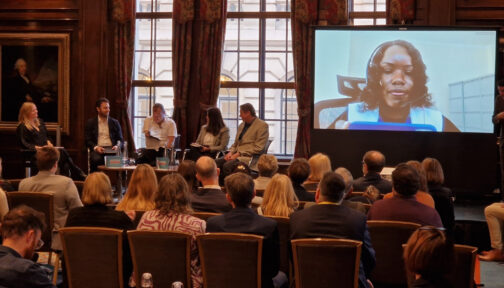Liz Ombati is a disability rights advocate based in Kenya who identifies as having a psychosocial disability. She regularly contributes articles on disability and women’s rights in the Kenyan media.
Here she explains why it’s time for the media to do more to accurately reflect the lived experience of people with disabilities.
What is written about disability – and often what is not written – is important. There are over one billion people with disabilities in the world, and many experience stigma and discrimination, or are completely left out of media coverage. Language and media representation play an important role in influencing public opinion and challenging stereotypes around disability. Disability campaigners have agitated for years for our recognition as rights holders, not as objects of pity or care. We want to see this reflected in media portrayals. I know that journalists also want to cover disability and represent people with disabilities in an empowering and respectful way.
This is by no means a definitive guide to writing about disability. It’s simply a starting point from my experience as a woman with a disability who has worked in campaigning and written for the media, combined with the learnings from work by Inclusive Futures partner Sightsavers – an organisation I’ve worked with on disability rights.

Author
Liz Ombati is an OPD (organisations of persons with disabilities) engagement officer with the African Disability Forum and works on Inclusive Futures programmes.
More about LizWhat is disability?
Considering the difference between impairment and disability is a useful starting point. Impairment is the injury, illness or condition that causes a loss or difference of function to an individual. Disability refers to the limitation or loss of opportunities to participate equally in society because of social and environmental barriers as the result of an impairment.
Disability inclusion is not about who ‘deserves’ things in life – it’s about rights, and barriers to those rights. Journalism needs to reflect this.
For example, instead of a story that assumes that a child with disabilities would never be able to learn in a mainstream school, the angle could be: ‘Why is that school inaccessible to that child? And what should change for the school to be accessible (or inclusive) for that child?’
Words matter
Word use is important, particularly when there are so many terms that are outdated and offensive. Sightsavers has come up with a useful guide on language to use. This includes a list of terms to avoid, such as “wheelchair-bound”, “mentally defective”, “differently-abled”. Alternatives could be “wheelchair user”, “a person with mental illness” or “intellectually disabled”, “person with a cognitive or physical impairment/disability”.
Language is subjective and ever-changing, so there are not always hard and fast rules. But one constant is to talk about people as they describe themselves.
‘People with disabilities’ or ‘disabled people’ – which one?
I personally base my communications on the principles of the UN Convention on the Rights of Persons with Disabilities. This uses person-first language, such as ‘people with disabilities’. However, many people prefer identity-first language, such as ‘disabled person’, which focuses on the disabling nature of society as affecting their identity. Choice of language is personal, and preferences should be respected. It’s always best to ask people which they choose.
“Nothing about us without us”
The most authentic media stories about disability are those that interview people with lived experience, not only their family, caregivers, experts, or doctors. For example, media stories about graduates or students with disabilities often focus on the sacrifices of family and caregivers, rather than the students themselves and the barriers they faced getting an education.
And the more voices the better, as one person’s experience of disability is not representative of everyone with a similar impairment.
Focus on the barriers
Quite often, media stories focus on disability as inherently negative and portray people as ‘victims’ of their disability. For example, someone may be presented as an object of pity or charity, or be described as being ‘afflicted by’ or ‘suffering with’ a disability, which is something tragic they need to ‘overcome’.
For most people, their impairment or disability is something they just live with, and the challenges they face are the barriers put up by society, not by their condition. So rather than using negative language about the disability itself, focus on barriers and solutions.
A good example is this article, where a deaf woman shares her own story of the ableist barriers she has faced in trying to find work she is highly qualified for.
Would your story be remarkable if the person featured did not have a disability?
Disability is sometimes covered as if it is remarkable that someone with a disability has been able to do regular things like get an education or a job, or get married. This reinforces stereotypes that these things are not typical for someone with disabilities to do.
Describing someone as inspiring solely because they have a disability, or ‘despite’ their disability, can appear patronising or pitying. It doesn’t recognise what their genuine achievements have been. There is also a danger of reinforcing disabilities as something inherently negative – rather than something some people just have – or failing to focus on the disabling nature of society.
Once again, “Nothing about us without us”
Ultimately, people with disabilities deserve the same respect and inclusion as anyone else in the media. To do this properly our voices and viewpoints need to be central to any story about us.
A checklist for interviews
- Are you speaking to the person your story is about?
- Have you asked them how they like to communicate? For example, they might require information in plain language, or need to have written communication, or prefer a call
- Have you made allowances for extra time that may be needed for things like chronic illness?
- Have you made sure any locations are physically accessible?
- Is the person you are interviewing representative of a whole community/topic, or do you need to find more voices or representative organisations?
- Would their story be newsworthy if they weren’t disabled?
- Are you interviewing people with disabilities about a range of issues, not just disability-focused ones?
Useful links
- Sightsavers: Disability and inclusion language guide
- United Nations: Disability and the Media
- United Nations: Disability-Inclusive Communications Guidelines
- International Disability Alliance: Language as a barrier to the participation and inclusion of persons with disabilities
- National Centre on Disability Journalism – Writing and editing
- CharityComms: Accessible communication
- Rooted in Rights: If You’re Writing About Disability, You Need to Read These Guidelines
- Amanda Morris: How to Report with Care on Disability
- Stella Young: I’m not your inspiration, thank you very much
- Women in Journalism: Language Matters: Disability
- Bond: Talking Disability: The new animation for those who dare to do it differently
This article was originally published on IBT’s website.
More news and opinions

Global Disability Summit 2025: Closing the gap between disability inclusion and development
Inclusive Futures is attending the summit in Berlin on 2-3 April. Visit our booth or attend our panel event to connect with us and learn more about our programme insights.

Sense International wins prestigious Zero Project award for its work with entrepreneurs with disabilities
Sense International has won a 2025 Zero Project Award for empowering individuals with deafblindness and complex disabilities in Kenya to build successful businesses and achieve financial independence.

Driving change: launching the six principles for inclusive development
Inclusive Futures and the UK Foreign, Commonwealth & Development Office marked International Day of People with Disabilities by jointly hosting an event to launch the six principles for inclusive development.